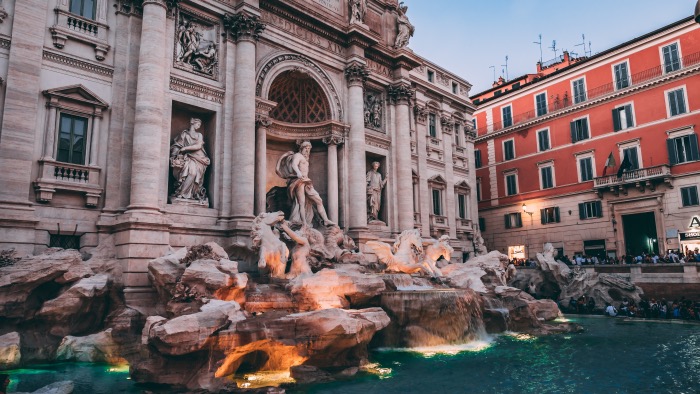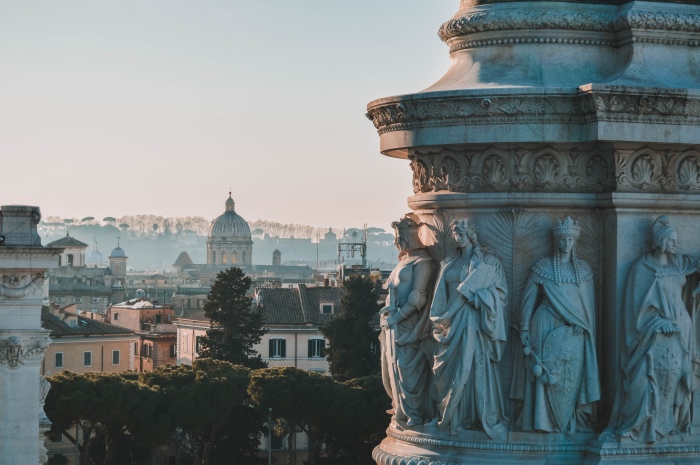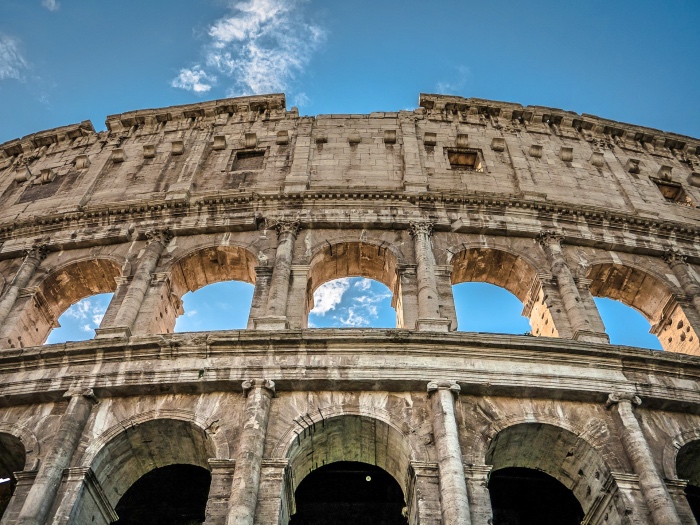
TELL ME WHERE YOU ARE GOING AND I WILL TELL YOU WHAT TO SEE
To exhaust in one article all the wonders to visit in Rome is a tall order, so I have selected the most significant attractions and some enjoyable experiences for exploring the city. Get ready to discover the Rome I loved and that continues to enchant me every time.

Musei da vedere a Roma
Rome is a treasure trove of museums, each with a unique history. They are truly many and varied, some better known, others hidden gems. For your convenience, you may choose to purchase the Roma Tourist Card, which provides convenient access to important museums in Rome.
Vatican Museums and Sistine Chapel
The Vatican Museums are a journey through art history, housing priceless collections ranging from classical antiquity to modern and contemporary art. Not to be missed are Raphael’s Stanza della Segnatura and the stunning Gallery of Maps. A visit cannot fail to include entry to the Sistine Chapel: here, Michelangelo’s celebrated works, such as the Last Judgment, marked a turning point in Renaissance art, leaving an indelible mark on art history.
Galleria Colonna
The Galleria Colonna , located in the Colonna Palace, is a treasure trove of private art. Here, works by Tintoretto, Perugino, Rubens and Bronzino coexist with masterpieces such as Annibale Carracci’s “Mangiafagioli” and Francesco Albani’s “Ratto d’Europa,” in a rich and fascinating historical context.
Capitoline Museums
The Capitoline Museums are home to iconic pieces such as the original equestrian statue of Marcus Aurelius, a copy of which adorns the Piazza del Campidoglio. Don’t miss Bernini’s Bust of Medusa and two intense works by Caravaggio, treasures of this extraordinary museum.
Galleria Doria Pamphilj
The Doria Pamphilj Gallery is a celebrated private collection that we can consider a page of art history. Its rooms are packed with works, such as those by masters like Caravaggio, Titian, Raphael, Guercino, Parmigianino, Carracci, and Bernini.
Palazzo Barberini
The Palazzo Barberini, a magnificent specimen of Baroque architecture, is the work of Carlo Maderno, Gian Lorenzo Bernini and Francesco Borromini. With the Corsini Gallery it houses thousands of works of art, ranging from the 13th to the 18th century, with pieces by Raphael, Caravaggio and Filippo Lippi.
Museo di Palazzo Venezia
The Museo of Palazzo Venezia, a 15th-century architectural jewel, holds the fascinating collections of Pope Paul II Barbo, the building’s first illustrious resident. Inside, you’ll also find works from Castel Sant’Angelo, the Kircherian Museum and the National Gallery of Ancient Art. A personal suggestion: don’t miss the opportunity to stroll in its beautiful garden, an oasis of peace in the heart of Rome, which can be visited for free.
National Gallery of Modern and Contemporary Art
Known as GNAM, the National Gallery of Modern and Contemporary Art in Rome has works in its spaces covering a period from the 19th to the 20th century. Among the must-see works, I invite you to linger in front of Gustav Klimt’s “The Three Ages of Woman,” in the energy of Jackson Pollock’s action painting, and in the sublime art of Antonio Canova.
MAXXI
Opened in 2010, MAXXI is the National Museum of 21st Century Arts. The structure, designed by architect Zaha Hadid, is home to hundreds of works ranging from the 1970s to the early 2000s. Temporary exhibitions and events are also held here.

Archaeological Sites in Rome
Rome, with its thousand-year history of global significance, is dotted with emblematic archaeological sites, vivid testimonies to a glorious past. The Colosseum is only the tip of the iceberg of this incredible heritage.
Terme di Caracalla
These impressive, surprisingly well-preserved ruins offer a plunge into the luxury and sociability of ancient Rome. Walking within these walls, one can almost hear echoes of conversations in the ancient Baths of Caracalla, once a center of social life and relaxation.
Colosseum
A visit to the Colosseum is a must for every traveler. I highly recommend that you opt for a guided tour, which will take you into the arena and the dungeons, giving you a unique perspective on the life and history of this symbol of Rome. The experience of standing where gladiators and beasts once faced each other is simply unforgettable.
Una visita al Colosseo è un must per ogni viaggiatore. Ti consiglio vivamente di optare per un tour guidato, che ti porterà nell’arena e nei sotterranei, offrendoti una prospettiva unica sulla vita e sulla storia di questo simbolo di Roma. L’esperienza di stare dove un tempo gladiatori e bestie si affrontavano è semplicemente indimenticabile.
Foro Romano
Walking through the Foro Romano is like walking a direct route to the heart of ancient Rome. This archaeological site can be visited jointly with the Colosseum and the Palatine, being part of the Colosseum Archaeological Park. I recommend you start by admiring the Forum from the Capitoline Hill terrace, where the view is simply breathtaking. From there, descend through the ruins to approach the Arch of Titus and walk among the remains of ancient temples.
Circo Massimo
Once the scene of Roman ludi, the Circus Maximus continues to be a living place where shows and events still take place. Imagining the games of yesteryear here makes the visit even more evocative. One tip: Consider combining a visit to the Circus Maximus with a visit to the Baths of Caracalla or other nearby archaeological sites. There are often combination tickets that offer a more advantageous opportunity to explore multiple sites.
Churches and Places of Interest in Rome
In addition to its priceless historical sites and museums, Rome is rich in churches, squares and monuments that are true symbols of the city. Some churches, moreover, hold priceless treasures.
Pantheon
The Pantheon, with its imposing dome and oculus that opens the sky inside, is a masterpiece of ancient engineering. It can be accessed with an entrance fee or a guided tour, and its interior also contains funerary monuments of personalities such as artists and rulers.
Altar of the Fatherland
Neoclassical in style, it was created as a national monument to Victor Emmanuel II and is therefore known as the Vittoriano. It is located in Piazza Venezia and with its grandeur is a symbol of national unity.
Trevi Fountain
The Trevi Fountain is not only an architectural marvel, but also a symbol of hope and desire, as evidenced by the tradition of tossing a coin into the water. Its majestic beauty and the play of water and light make it a must-see.
Trinità dei Monti
Located at the top of the famous Spanish Steps, Trinità dei Monti is a church that offers one of the most beautiful panoramic views of Rome. The enchantment of this place is revealed at all times and, along with the nearby Fountain of the Barcaccia, is well worth a stop (and a shot!).
Castel Sant’Angelo
Castel Sant’Angelo, initially the mausoleum of Emperor Hadrian, has spanned history as a military structure, prison and papal residence. To explore it fully, you’d better devote at least three hours to it. With this particular guided tour, you can also walk along the fortified walkway.
Piazza Navona
A trip to Piazza Navona is essential to admire the grand Fontana dei Quattro Fiumi, the work of Gian Lorenzo Bernini. Originally the square was concave to allow for a particular custom: flooding the surface to provide an opportunity to cool off during hot weather.
Jewish Ghetto
Rome’s 16th-century Jewish Ghetto is one of the oldest in the world; it was established by order of Pope Paul IV. Walking through its streets, one breathes in the history and stories of those who lived here, making it unique and significant. The beating heart of this neighborhood are the Synagogue and the Jewish Museum inside, which should be visited to delve into important cultural records.
Church of St. Louis of the French
In the Contarelli Chapel of the Church of San Luigi dei Francesi are some of Caravaggio’s most famous works, dedicated to St. Matthew.
Basilica of San Pietro in Vincoli
With undoubtedly fine architecture, this religious building is best known for being the site that houses the tomb of Pope Julius II, expertly crafted by Michelangelo and whose emblem is the monumental Moses. If the idea of a tour of Rome’s most beautiful churches intrigues you, this experience then is a must.
How to get around Rome
Rome is a unique city. One can get around on foot or by using other alternatives that combine the need to move from one side of the city to the other but also satisfy the desire to admire Rome from every angle.
In Rome, in addition to the classic tourist routes, you can also have original experiences, so that you can enjoy the city in an alternative way or delve into some particular aspects. For a practical and almost complete tour, for example, you can choose to board a hop-on hop-off tourist bus, with which you can stop at major attractions.
To literally see another side of the city, you can go down into the underground passages of Rome: you can explore ancient catacombs or dive under the Trevi Fountain.
Rome is a city with so many wonders to discover that it would take days to see them all. Fortunately, this is precisely why staying dry-mouthed is impossible: there is room for those who love art, history but above all beauty.

